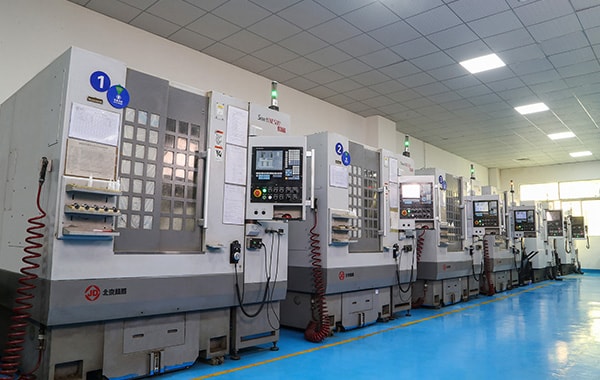Core Advantages of 5-Axis Machining
Sub-Micron Precision Control
- RTCP (Rotating Tool Center Point) Technology: Enables dynamic compensation of the tool center point, ensuring contour error in curved surface machining ≤ 0.005 mm (e.g., impeller blades).
- Real-Time Thermal Deformation Compensation System: Uses machine body temperature sensors combined with AI predictive algorithms to offset positioning drift caused by high-speed cutting, improving accuracy by 40%.
Significant Efficiency Boost
- Tilted Work Planes Strategy: Reduces repeated fixturing, shortening machining cycles for complex parts by 60% (e.g., automotive engine blocks).
- Intelligent Tool Life Management: Adjusts feed rates dynamically based on cutting force feedback, extending carbide tool life by 35% (proven in aerospace titanium alloy machining).
Comprehensive Coverage of Complex Geometries
- Non-Orthogonal B/C Axis Structure: Supports ±110° tilt machining, enabling one-step forming of deep cavities and negative-angle areas (e.g., multi-curvature slots in artificial knee joints).
Deep Industry Applications:
| Industry | Typical Parts | Technical Solution | Performance Indicators |
|---|---|---|---|
| Aerospace | Turbine blades | Adaptive NURBS interpolation + five-axis air film hole drilling | Surface roughness Ra 0.2 μm, aerodynamic efficiency +15% |
| Medical Devices | Spinal fusion cages | Medical titanium alloy micro-texture machining (Ø0.3 mm ball-end mill) | Bone fusion speed +50% |
| Energy Equipment | Nuclear power sealing rings | Ultra-hard alloy mill-turn machining | Flatness ≤ 5 μm, leakage rate reduced to 10⁻⁹ Pa·m³/s |
| Precision Molds | Automotive bumper cavities | High-speed trochoidal milling (20,000 rpm) | Machining time -45%, tool cost -30% |
Technology Upgrades
Integrated Smart Process Chain
- CAM/CNC Unified Platform: WorkNC 2025 enables coupling simulation of toolpaths with machine tool dynamics, achieving 99.6% collision risk prediction accuracy.
- Digital Twin Closed-Loop Control: Siemens NX virtual commissioning shortens trial cutting cycles to one-third of traditional methods.
Breakthrough in Core Component Localization
- High-Rigidity Motor Spindle by Zhongke Times: 40,000 rpm, radial runout ≤ 1 μm, replacing German imports at 50% lower cost.
- Huazhong CNC Five-Axis Linkage Kernel: ISO 10791-7 certified, achieving synchronous accuracy of ±3 arc seconds.
Comprehensive Talent Development System
Industry-Education Integrated Training Platform: DMG MORI-certified courses combined with an industrial-grade five-axis training center, producing 1,200 engineers annually.
Future Trends
- Quantum Sensing Precision Upgrade: Laser interferometer closed-loop feedback systems (0.1 nm resolution) applied to optical freeform surface machining.
- Cloud-Edge Collaborative Intelligent Control: Huawei Pangu AI model optimizes cutting parameter databases, boosting machining efficiency by another 25%.
Industry Data Insights
According to the International Journal of Machine Tools & Manufacture 2025 report:
- The penetration rate of 5-axis machining in key aerospace engine components has reached 92%, up 37 percentage points from 2020.
- In the global high-end medical implant market, 80% of precision parts rely on 5-axis machining technology.
Conclusion
5-axis CNC machining has evolved from an optional technology to a strategic infrastructure for high-end manufacturing. Its technical depth and industrial chain integration capabilities are redefining the manufacturing boundaries of aerospace, biomedical, and other sectors.
To secure a competitive edge in the new wave of industrial transformation, companies must build a strong moat in core algorithms (such as B-spline interpolation), process databases, and cross-disciplinary talent development.
References:
1.Siemens, Five-Axis Machining White Paper (2025)
2.China Machine Tool & Tool Builders’ Association, High-End CNC System Development Report
3.CIRP Annals, Frontiers of Precision Manufacturing Technology (2024)



